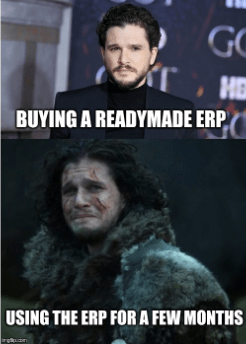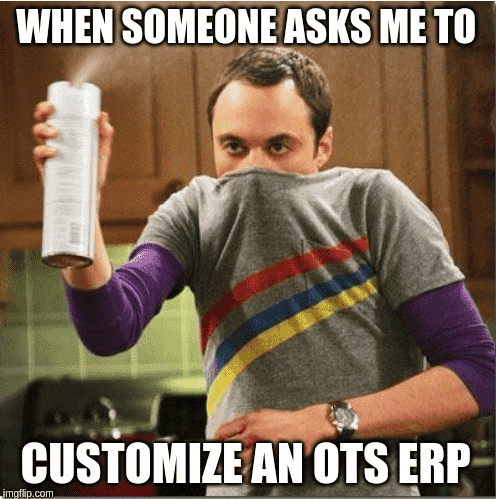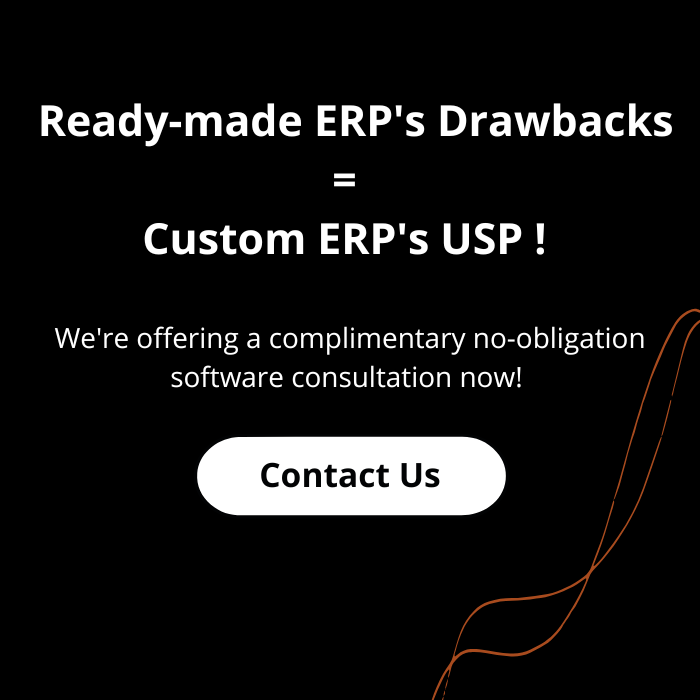The global ERP software market is expected to be worth $41.69 billion by the year 2020 . There is no doubt that ERPs improve business performance and simplify business operations, all at once. Enterprises know the operational, strategic and organization benefits that ERP brings along in order to position their company for growth. In this article, we speak about why custom ERP is preferred over off-the-shelf ERP, what will be the approach for enterprise software development and how much it costs to develop an ERP from scratch.
No two organizations are the same. Even if they sell similar products and are in the same market niche, they are bound to have different business processes. Off-the-shelf ERPs don’t get this. They make software for all enterprises, generalizing the features and functionalities. They don’t leave businesses with much scope for customization or flexibility. So, enterprises start looking for something custom made. We, in this article, will discuss whether custom ERP development is a good idea and if so, how much does an ERP system cost?
Try our free app cost calculator
Without further ado, let’s begin!
There can be two types of ERP: Off-the-shelf and custom. Let’s start with comparing Custom vs off-the-shelf ERP and see why businesses prefer Custom ERP development?
Your ERP Software: Should It Be Custom-Built Or Off-The-Shelf ?
We often get asked why a business should opt for custom made ERP solutions when there are ample off-the-shelf ERPs that they can buy with the click of a button. Let us help you choose.
[1] Custom ERP Is Tailored To Meet All Your Business Needs.
When you tailor-make an ERP, you make sure that it is designed to fit all your business needs. This is not the case with OTS (Off-the-shelf) software. If you buy a ready-made ERP, you need your business to fit into it. In order to make the ERP relevant to anyone and everyone, across all industry verticals, they include loads of irrelevant modules and functionalities.
Did you know – Business giant Tesla too built an ERP in-house?
With custom ERP development, you have a competitive edge over your competitors as the system is uniquely built for you and no other organization can have the exact same software.
Custom ERP also means getting the system to market faster. With some off-the-shelf solutions that have too many integrations, it can take more than a year to roll out the software.
[2] Cost
Many people believe that significant money is saved with OTS ERP. That is however not the case. Initially, the cost of a readymade software might seem reasonable to you. But, when you think about customizing it to fit your specific business needs, the cost rapidly increases.
This is because the ERP development company that you hire will need to go through the entire code structure and then customize on top of that. Also, in the case of upgrades, if your ERP is highly customized, every upgrade will have to be redone with every upgrade. And ERPs, in general, gets updates twice a year. According to a report, almost 40-60% ERPs needs to be custom coded exclusively for business.
Also, as and when your business becomes scalable and you need to add more users to the ERP, your cost in the case of a readymade system will skyrocket. This is not an issue with custom-developed enterprise systems as the architecture was built keeping in mind the future needs of the business. So, if scalability needs to be amplified, all you need to pay is for the system infrastructure and not a penny for the increased no. of users.
[3] Integration With External Systems
With custom solutions, external system integration is discussed prior to development. Even with integrations post-development, custom-developed ERP systems are highly flexible in incorporating those too.
With off-the-shelf ERP solutions, third-party integrations are not only costly but often complicated. Most of the off-the-shelf software is rigid and difficult to play with. Also, compatibility issues that this software bring along can make integration difficult in the long run.
Read more : Enterprise Application Integration
Off-The-Shelf Systems Make Sense When You Run A Small Business. It doesn’t add much to the cost and also it’s less risky. Also, businesses looking for an immediate solution to their ERP woes can opt for off-the-shelf software.
But, businesses with long term savings, flexibility, scalability and compatibility in mind would be better off choosing a custom developed ERP. Yeah, it may take an initial few months to develop the custom solution, but, come on, Rome wasn’t built in a day either.
Okay Next Up, How To Approach ERP Solution Development?
Quoting myself again, “No two businesses are the same”, so an ERP for a hospital can never be similar to an ERP for a school. The requirements will be completely different, so will be the scalability and flexibility of the system. In this section, we will walk you through the steps of “developing a custom ERP”.

Step 1: Choose A Software Development Company
Business software is developed keeping in mind three things – Robustness, Performance, and Scalability. Make sure you hire an Enterprise Software Development company who has expertise in providing customized, scalable and cost-effective enterprise application development services.
Remember – ERP development is an iterative process and you will constantly need changes and updates to your ERP. Hire someone who can commit to long-term development and provide support at all times.
Step 2: Define Your Requirements
The main purpose of custom ERP software development is to make it feature-rich so that it compliments your business. For this purpose, you need to have a solid concept of what purpose the custom ERP solution will solve and what features it requires for fulfilling the purpose.
Note down your requirements in a doc and try to figure out complete user flow. If the idea seems somewhat on track, start discussing the requirements with the software vendor.
Step 3: Documenting And Blueprinting
Once the discussions are over and both you and your vendor have a holistic idea of the software product, document it. A clean, detailed and easy to understand BRD (Business Requirement Document) should have a complete list of all the deliverables and constraints and should have the complete user flow mentioned.
This will help translate the requirements to the developers as well as help avoid cost and time overruns.
The next step is planning – wireframing, defining site architecture, selecting the technical stack, resource estimates, etc. Proper project planning helps in better utilization of the company’s resources and makes sure that the time allotted for each phase is used optimally.
Step 4: Design And Development
Once planning is done, the next step is designing the ERP. The layout, the screens, buttons, navigation, and other visual elements are all added during design. Then the developers start coding and transforms the static web pages into working ERP.
There are certain things that need to be considered during the development of an ERP
[a] Workload and resource management
[b] Database migration and consolidation
[c] Integration with existing legacy systems
[d] Hosting and data warehousing
[e] Security
[f] Scope of extendibility and customization prior to development, etc.
[g] Master Data Ownership
This stage is highly dependent on the blueprinting stage. If you mess up during this stage, your development will go downhill too.
Read more : Enterprise Application Development challenges and how to overcome them?
Step 5: Testing
This is important as the ERP that is developed for automating business processes is not allowed to make mistakes. An ERP must be thoroughly tested before making it live.
** Always have a staging server backup so that if production is severely broken after deployment, the backup can be used to restore data.
Now that we have an idea of how ERP development works, let us see the ERP technologies that are a good choice for the development purpose.
ERP Technologies
For the database, one can choose, PostgreSQL, MSSQL, ORACLE SQL. For programming, opt for Java, PHP or Python. The frontend technologies include JavaScript, Angular JS, React JS and Vue.JS.
Read more: 5 top Enterprise application development trends of 2019

So, finally, how much does it take to develop an ERP from scratch?
How much developing an ERP from scratch will cost depends on :
[1] Hiring developers in-house, nearshoring or offshoring
[2] Features and functionalities
[3] On-premise or cloud-based
[4] No. of users and volume of data
[5] Complexity of software integration and data migration
[6] Extensive testing
Given all these, ERP development for a small business will range from $15,000 – $40,000. For a medium-sized business, it will somewhere be around $40,000 – $80,000. For an enterprise with hundreds of users, it will exceed $80,000.
*** All prices are based w.r.t offshoring the ERP development. If you hire in-house developers or nearshore, your price will increase significantly.
Apart from these, regular maintenance, software customization, and upgrades will keep adding to the cost according to its occurrence.
Why Does Developing Your ERP Solution With BinaryFolks Make For A Wise Choice?
Driven by ex-engineers from Google, Amazon & Salesforce
101% Value For Money (+1 for Our Complimentary Consultation before You Spend Your 1st Dollar!)
Reviews That You Can Verify!
Safeguarded Business With An NDA
Out-Of-The-Box Innovations
Eye For Details
Questions Galore (Until Your Requirement & Our Understanding are mirror copies!)
Insight-Rich Scope Enhancement
Intense Domain Expertise
Close-knit feedback loop
The Bottom Line
I know choosing between a custom ERP and an off-the-shelf ERP is nothing less than a challenge. But, speaking from the 8 years of custom software development experience we have, I have never seen a company that didn’t have to customize the OTS ERP in order to meet their business needs.
Read more : ABCs Of Custom ERP
So, a custom ERP might seem a little extra now, but, it would be much better and cost-effective in the long run with personalization, flexibility, and fully-tailored support. If you’re interested in getting even more personalized assistance, you can reach out to us anytime. The first consultation is on us.




